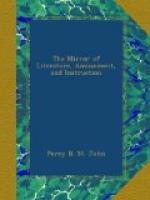SILBURY HILL.
Grave of Cunedha, were it vain to call
For one wild lay of all that
buried lie
Beneath thy giant mound? From Tara’s
hall
Faint warblings yet are heard,
faint echoes die
Among the Hebrides: the ghost that
sung
In Ossian’s ear, yet
wails in feeble cry
On Morvern: but the harmonies that
rung
Around the grove and cromlech,
never more
Shall visit earth: for ages have
unstrung
The Druid’s harp, and
shrouded all his lore,
Where under the world’s ruin sleep
in gloom
The secrets of the flood,—the
letter’d store,
Which Seth’s memorial pillars from
the doom
Preserved not, when the sleep
was Nature’s tomb.
H.
* * * * *
FINE ARTS
(For the Mirror.)
* * * * *
“The way to be an excellent painter is to be an excellent man—and these united, make a character that would shine even in a better world than this.”—JONATHAN RICHARDSON.
The sister arts of Painting and Engraving have been making great progress in England for some time past, and we are disposed to think this a subject of congratulation and importance to all classes of the community.
The literature of the Fine Arts is likewise becoming more and more popular every day. They form a prominent feature in every new literary project, and not unfrequently literature, to use a hackneyed phrase, is made their vehicle—like the namby-pamby of an English opera for the strains of Rossini or Weber. The public are contented with excellence in one department and mediocrity in the other; they cannot be constantly admiring—that is out of the question—and it is probably on this account that much of what appears below par is tolerated and even encouraged.
We will not go the length of assenting to the proposal of converting Sir Joshua Reynolds’s Lectures into Sermons, by the mere alteration of the terms of art into scriptural phraseology; but we venture to assert that much national good is likely to result from these advances of art, and its constant introduction into all our amusements. That it promotes the growth of virtue is too old an axiom to be refuted:
——Ingenuas didicisse
fideliter artes
Emollit mores, nec sinit esse feros.
“The Italians commonly call a taste for the fine arts, or skill in them, by the name of Virtue. They term the productions of artists objects of virtue; and a person who has a taste for such things is denominated a virtuoso, that is, a virtuous man.” Such is the language of the Edinburgh Review, in commencing an article on a recently-published translation of Lanzi’s History of Painting in Italy, in six octavo volumes—and what a delightful relief is this from the party declamations which usually occupy so large a portion of that “critical journal.” But this is not singular, for it is now no uncommon thing to see a large letter column of a newspaper, and a similar proportion of a printed sheet published at twopence, alike occupied by “the Fine Arts.”




